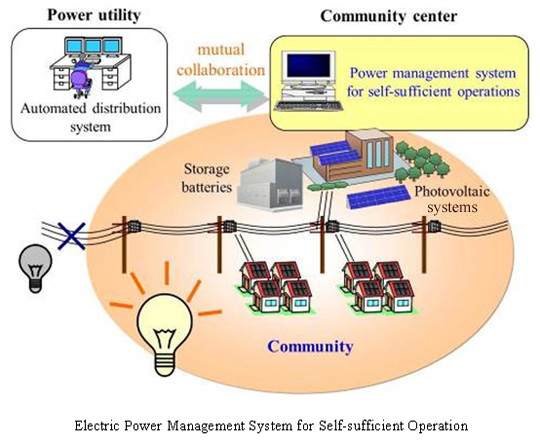News Release Archives
Note that the releases are accurate at the time of publication but may be subject to change without notice.
FOR IMMEDIATE RELEASE No. 2730
Mitsubishi Electric Develops Electric Power Management System for Self-sustained Operation in Communities
Enables self-sufficient power supply for more than one week
TOKYO, February 14, 2013 - Mitsubishi Electric Corporation (TOKYO: 6503) announced today that it has developed a prototype electric power management system that combines an ideal mix of storage batteries and photovoltaic power generation for self-sustained operation in communities during extended blackouts. The technology was achieved through the company's Smart Grid and Smart Community initiative.


Until now, self-sufficient power management at the community level has been impossible due to difficulties in securing safe power distribution and switching over from the power-supply systems of power utilities. In light of increasing demand for power and needs for more flexible power systems to mitigate extended blackouts caused by natural disasters such as earthquakes and typhoons, Mitsubishi Electric has developed this technology to enable self-sufficient power management based on the coordination of systems operated by communities and electric power companies, thereby maximizing the use of existing power distribution networks. The technology can reduce the impact of power outages, improve the reliability of power supply and help communities to realize more safe and secure living environments.

Key technologies

Mitsubishi Electric's newly developed technology vs. conventional energy self-sufficiency systems
Key technologies
| 1) | Ensuring safe, self-sufficient operations during blackouts
|
|
| 2) | Automatic transition to self-sufficient power within 20 minutes
|
|
| 3) | Controlling supply and demand to avoid power shortage
|
|
Mitsubishi Electric's newly developed technology vs. conventional energy self-sufficiency systems
| Function | Performance | |
| Newly Developed | Through coordination with automated distribution systems of electric power companies, self-sufficient power can be supplied on the scale of tens to hundreds of houses. | Power can be supplied continuously for more than one week, including by adjusting power consumption in the community, if necessary. |
| Conventional | The conventional distribution lines of electric power companies cannot be used. | Adjustment is possible only on the power-generation side, so self-sustained supply is limited to the short term, unless a large generation plant is installed. |
Inquiry
Customer Inquiries
Mitsubishi Electric Corporation